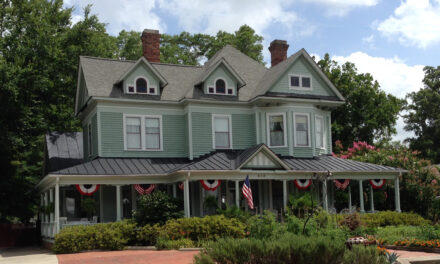The April 4 Greensboro Symphony concert, given in War Memorial Auditorium, built from the very good to culminate in a spectacular example of the artistic experience at its best. The program-all middle-period works by Beethoven-was unusual. In his well-organized Prelude (pre-concert lecture), UNCG’s Art Tollefson gave a compact overview of the characteristics of all three periods of Beethoven’s style and played excerpts of the program that exemplified those of middle Beethoven: driving chords, dense scoring (compared to classical composers such as Mozart and Haydn) and abrupt key modulations.
All three characteristics were heard immediately in the opening three chords of the Overture to Coriolan, Op. 62 (1802), one of the composer’s stormy works. Stuart Malina was especially sensitive in his control of dynamics. The unusual placement of the timpani, in the right back corner, near the double basses, allowed tight ensemble between Principal William Congdon and the low strings, providing a solid bass line All the string choirs sounded fine. I liked the cellos in their repeated figure and their warm tone just before the quiet pizzicato portion that ended the piece. The horns and woodwinds were very good, and the two bassoons were heard to great advantage throughout the evening. Only a slightly premature entry by a violin early on detracted from the important dramatic Beethoven silences.
These virtues were also on display in the Symphony No. 8 in F, Op. 93 (composed 1811-1812). From the stage, Malina reminded us that Beethoven held the Eighth Symphony in higher regard than the Sixth and Seventh. Malina aptly described it as a gem that is too often overlooked in favor of the big, odd-numbered symphonies. Well sprung rhythms and sensitive dynamics characterized Malina’s joyful interpretation. I made numerous notes about the fine playing of various sections, not least the bassoon pair. I suspect bassoonists love No. 8 like cellists and violists love Brahms. Again the tight synchronization between the timpani and the low strings was outstanding. Only in the trio of the Ländler-like Menuet did the horns prove to be rather more human than divine but, as Pepys would have said, “they played bravely” on. The pairing of bassoons and timpani in the finale was marvelous, as indeed was the whole.
The fine quality of the first half of the concert did not prepare me for the truly rare and extraordinary musical experience of the Concerto in D for Violin and Orchestra, Op. 61 (1806). Too often in modern concert formula-overture, concerto and symphony-the audience “bait” that is the concerto is the least musically satisfying part of the evening. A big-name soloist with his part almost on auto-pilot drops into town for a quick rehearsal and at the performance a generalized orchestral framework is added with little musical give and take. That’s why musical connoisseurs prefer chamber music where perceptible interplay between co-equal partners most often takes place. In Greensboro, intimate give and take among and between artists was the overwhelming impression of the performance of soloist Dmitry Sitkovetsky, Malina and the orchestra. Malina held the dynamics so that truly quiet passages had their full value and so the soloist never had to force his tone or over-project. Sitkovetsky obviously listened closely to all the other musicians and responded to them when he was playing. I caught sight of his wink to the bassoonist at the end of a small duet. String choirs played as if like each section was part of a quartet. The interpretation sounded fresh, as if the piece were being newly examined with nothing taken for granted. It was one of the finest evenings of music-making I have experienced in nearly thirty years of concert-going. Bravo!
In addition to Malina’s priceless selection of truly musical soloists, I will miss his superb informal give and take with his guests and interested audience members at his after-concert “Postludes,” where every question is frankly engaged. At this one, Sitkovetsky indicated that he had used Fritz Kreisler’s cadenza, which has a number of double stops. He has had his violin, a Stradivarius made in 1717, for nineteen years; previous owners have been Accardo, Laredo (for nine years), and Milstein (briefly), and while Jacques Thibaud never owned it, he borrowed it when he made piano trio recordings with Casals and Cortot. In response to a query about the crisis in classical music, he was more sanguine about live concert performances than recordings. Of the later, he said companies expected too much “of what classical music never was,” a high volume industry. He deplored the disappearance of boutiques where experienced staff could guide novices in their choices. Unlike popular music where the audience expects to be “entertained,” in classical music, the audience has to be actively engaged with the musicians. His motivation for the high standard of his performances come from living up to the example of his parents: his father was a famous Russian violinist and his mother, Bella Davidovich, whom he said was as the most professional musician he has known-never late, never unprepared. In addition, he noted, in Russia, in the 1960s, music was regarded as a “calling” and not just a job or a profession.
I will be tempted to duplicate the basic repertoire on CDs with Sitkovetsky. His Virgin Double CD of the Shostakovich and Prokofiev violin concerti is a “steal.” I have long treasured an Orfeo CD of the three Grieg sonatas he made with his mother. His recent Virgin recording was on sale in the lobby for $20. I suppose that would prevent the GSO from issuing its own CD of the concert, which would be a pearl beyond price.
[Note: This program will be repeated at 8:00 p.m. April 6. See our calendar for details.]











